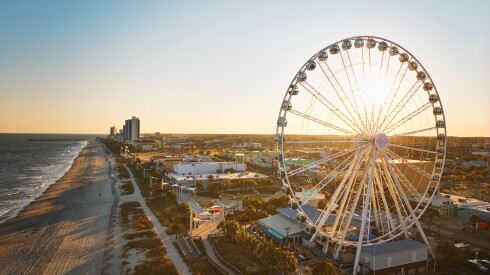Rates: From $715 per person
The Afar take
Gorongosa National Park is Africa’s most extraordinary comeback story—and with the July opening of Chicari Camp in July 2025, travelers have a new way to experience it. Once a battlefield during Mozambique’s brutal civil war (1977–1994), this 1,540-square-mile wilderness area was left in ruins: elephants slaughtered, predators gone, bones littering the floodplains.
Then came a bold restoration effort. Since 2008, American philanthropist Greg Carr and the Mozambican government have poured resources not just into rewilding but also into schools, farms, and health programs for surrounding communities. The result is staggering: lions roar again, African wild dogs thrive, and 150 pangolins have been reintroduced. More than 70 universities use Gorongosa as a living laboratory, and the park’s biomass is nearly back to prewar levels. Thanks to all the conservation work happening there, the park is also now one of Mozambique’s largest employers.
Chicari Camp, named for the traditional clay drinking pot of the local Mwani group, is the second safari lodge under the Gorongosa Safaris banner. Its arrival signals a new phase in Gorongosa’s evolution: The park is shifting from a conservation success story people read about to a safari destination that’s easier than ever to experience firsthand. Note that Gorongosa isn’t like the more famous national parks in sub-Saharan Africa, including the Masai Mara in Kenya or Kruger National Park in South Africa, where habituated animals like lion prides are more relaxed and easier for humans to spot and photograph. The park is less visited and still in the recovery process, but that’s exactly what makes Chicari so compelling: it puts you at the heart of one of conservation’s great redemption stories, as that tale unfolds in real time.
Who’s Chicari Camp for?
Chicari is not a bling-and-butler safari. It’s for travelers who’ve already checked off the Big Five (lion, leopard, elephant, rhino, cape buffalo) and are ready for the Big Why—why this place matters, ecologically and culturally. It’s not for your influencer friend who wants an infinity pool shot (there is no pool) and a Nespresso machine before breakfast.
What you will find is a pared-back, unpretentious camp that appeals to travelers who value the rebuilding and impact story as much as sightings. That includes those who want to understand how a park rebuilds itself after near collapse and how conservation is woven into the lives of nearby communities.
For those who stay five nights or more, there’s a rare and extraordinary bonus. The camp offers an opportunity to walk alongside pangolin conservationists in the field. Guests might see the world’s most trafficked and endangered species up close.
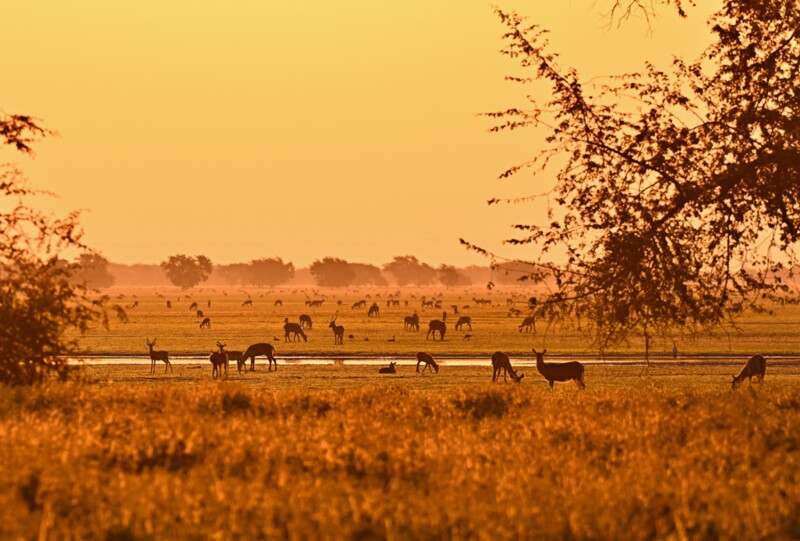
Chicari Camp is surrounded by seasonal wetlands filled with wildilfe.
Photo courtesy of Chicari Camp
The location: Gorongosa National Park, Mozambique
Gorongosa National Park sits at the southern edge of Africa’s Great Rift Valley, where golden savannas give way to fever tree forests, crater lakes, seasonal wetlands brimming with hippos, and, high above, the misty rainforest slopes of Mount Gorongosa, a critical watershed for the entire region.
Most guests fly to Johannesburg in South Africa and then to Beira or Vilanculos (so you can pair your safari with a beach stay). From these airports, they hop into a charter plane (35 minutes from Beira or one hour and 25 minutes from Vilanculos), landing at a grassy strip inside the Gorongosa National Park, where warthogs are often the welcoming committee.
Chicari overlooks a year-round pan frequented by grazing waterbuck, drifting pelicans, and the occasional African wild dogs. Surrounded by palms and fever trees, it offers sweeping views of the surrounding landscape.
Chicari Camp puts you at the heart of one of conservation’s great redemption stories, as it unfolds in real time.
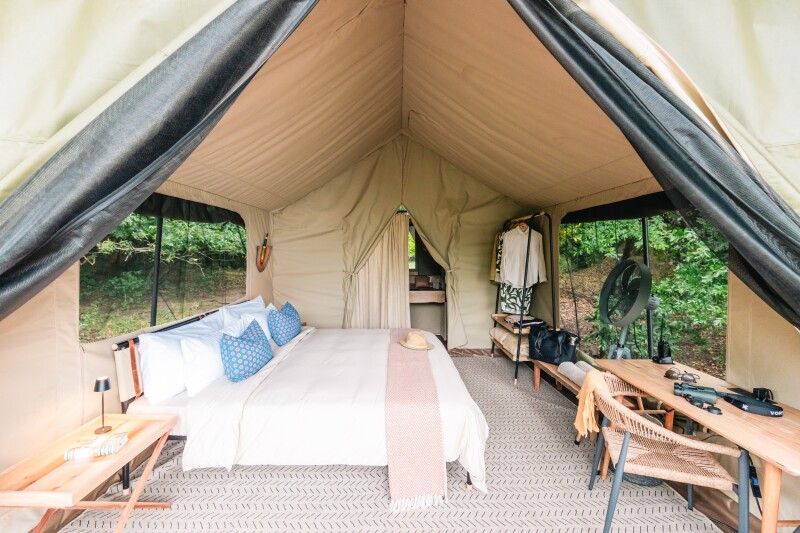
Accommodations at Chicari Camp
Photo courtesy of Chicari Camp
The rooms at Chicari Camp
Chicari’s design is centered on having a minimal impact on the surrounding land. Created by the architects behind the camps Tawana in Botswana’s Okavango Delta and Kruger’s Ngala Treehouse, the modular build allows the camp to be seasonal (the camp operates May to December and is taken down during the rainy season) and blend seamlessly with its palm and fever tree environs.
Ten tents (eight standard and two Treehide family units) are generously spaced among palms and fever trees for privacy, and their neutral colors and materials blend into the bush. One misty morning, with coffee mugs in hand, I watched Southern ground hornbills hoot in the distance as a pack of African wild dogs trotted through the fog.
Inside, the tents are lovely but not plush. They’re spacious, with comfy beds, quality linens, and hot showers that have excellent water pressure. There’s no air conditioning, so hotter months may test some travelers’ tolerance, but in July, during the Southern Hemisphere winter, I was happy under a blanket with hot-water bottles tucked beside me.

Much of the food and drink at Chicari Camp comes from community gardens or from the nearby coast.
Photos courtesy of Chicari Camp
The food and drink at Chicari Camp
Dining at Chicari was thoughtful and satisfying, with beautifully plated dishes that let local ingredients shine. Crisp, white linens dress the tables, but there’s no pretension. Much of what you eat is woven back into Gorongosa’s broader ecosystem: Greens come from community gardens, seafood makes the short hop inland from Beira, and honey and coffee come from Gorongosa-linked projects, so your meal is tied back into the park’s broader conservation efforts.
I loved the fillet with Gorongosa coffee sauce one evening, and on another, we were handed steaming mugs of velvety butternut soup the moment we stepped off the game drive vehicle. And yes, there’s plenty of South African wine and gin and tonics to go around.
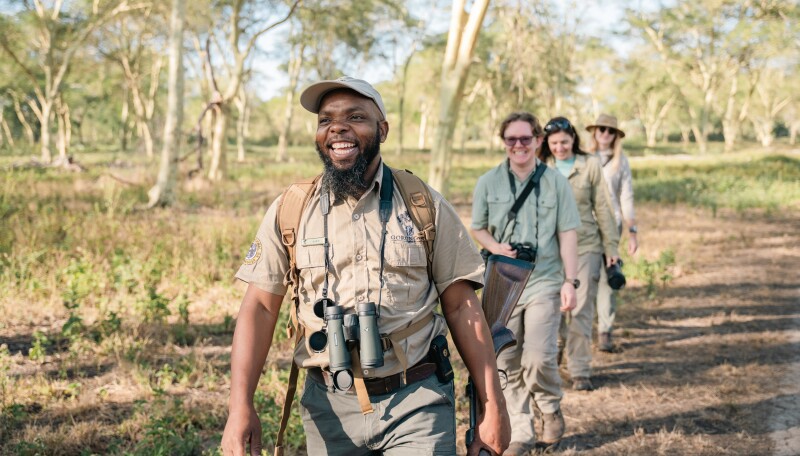
Chicari Camp’s walking safaris offer visitors a close-up look at the wilderness of Gorongosa.
Courtesy of Chicari Camp
Staff and service
Service and staffing are where Chicari shines. Most camp staff are from nearby villages, trained through Gorongosa Safaris, and the result is genuine service where everyone exudes passion for the park. Guides are sharp and intuitive: our driver handled the park’s famously wary elephants with calm, and walking safaris were led with equal caution and care, thanks to great training and deep knowledge of the landscape.
Accessibility
Chicari Camp is remote and seasonal, which offers some challenges when accommodating travelers with limited mobility. There are raised wooden walkways that connect tents and central areas. It’s best to contact the camp directly to ask about what on-site arrangements can be arranged, including assistance-up steps, vehicle support, and accessible bathrooms.
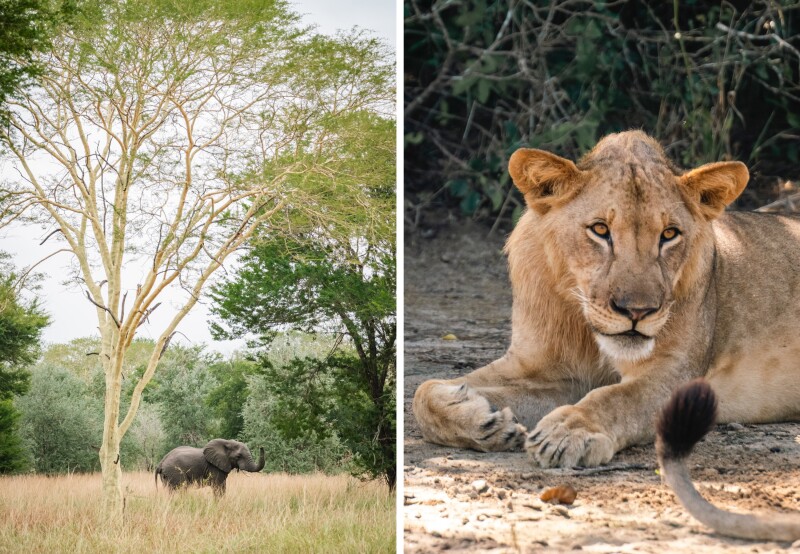
Wildlife spotting at Chicari Camp may take more patience, but the payoff is big.
Photo courtesy of Chicari Camp
Wildlife viewing at Chicari Camp
Game drives form the backbone of a stay at Chicari Camp. The game can be harder to spot here than at other famous parks, but an abundance of patience and longer stays will reward visitors with incredible sightings. Over the course of a week, we tracked lions, glimpsed African wild dogs, and ticked off the usual safari staples, such as impala, zebra, and hippo. The real spectacle, though, lies in the scale of resurgence: Vast herds of waterbuck graze the floodplains in numbers that once seemed impossible.
Walking safaris peel back layers you’d miss from a vehicle: matabele ants masking their trails with military precision, bushbuck flickering through the fever trees. (For those staying five nights or more, the aforementioned pangolin program is a must.) Chicari also gives guests rare access behind the scenes. At the on-site EO Wilson lab, based in the park headquarters, visitors can meet scientists studying everything from ancient shark teeth (a reminder that this land was once seabed) to elephant herd recovery. Seasonal boating on the Urema floodplain rounds out the offerings, especially for birders, who will find paradise here.



